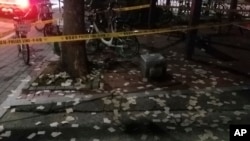The influential sister of North Korean leader Kim Jong Un warned of a new response against South Korea if the South continued with loudspeaker broadcasts and scattering leaflets.
"If the ROK simultaneously carries out the leaflet scattering and loudspeaker broadcasting provocation over the border, it will undoubtedly witness the new counteraction of the DPRK," Kim Yo Jong said in a statement late Sunday carried by state news agency KCNA, using the official names of South and North Korea.
South Korea resumed loudspeaker broadcasts directed at North Korea on Sunday, its military said, following through on a warning that it would do so if Pyongyang kept sending balloons carrying trash into the South.
North Korea on Saturday launched about 330 balloons with trash attached; about 80 of them landed over the border, South Korea's military said. On Monday South Korea said a further 310 balloons had been launched, with about 50 landing in the South.
"This is a prelude to a very dangerous situation," said Kim, a vice department director in the ruling Workers' Party, referring to the South's loudspeaker broadcasts.
Pyongyang started sending balloons carrying trash and fertilizer, including possible manure, across the border in May, calling it retaliation for anti-North leaflets flown by South Korean activists as part of a propaganda campaign.
"Seoul does not want military tension at the inter-Korean border, and Pyongyang does not want outside information threatening the legitimacy of the Kim regime," said Leif-Eric Easley, a professor at Ewha University in Seoul. "For both sides, ‘escalating to deescalate’ is a risky proposition."
The U.S.-led United Nations Command, which oversees the armistice that established the Demilitarized Zone between the two Koreas as fighting ended in the 1950-1953 Korean War, has said it is investigating the balloons, including the reports of possible fecal matter and other waste products.
"We’d hope that everyone would come to the table to resolve their issues," said U.S. Army Colonel Isaac Taylor, a spokesman for United Nations Command.
North Korea has in some cases fired weapons at the balloons and speakers.
South Korea stopped the broadcasts under an agreement signed by the two Koreas’ leaders in 2018, but tensions have increased since then as Pyongyang pushed ahead with weapons development.
South Korea's broadcasts include world news and information about democratic and capitalist society, with a mix of popular K-pop music. The sound is believed to travel more than 20 kilometers (12.4 miles) into North Korea.
North Korean troops have been seen clearing trees and building fences within the Demilitarized Zone in recent weeks.
Taylor said that United Nations Command does not assess that the intent of the work is to enable a "disparate" military buildup in the border zone, which would be a violation of the armistice.
He noted that since North Korea's recent declaration that unification with the South is no longer a goal, it has pursued measures to "harden" its boundaries.












